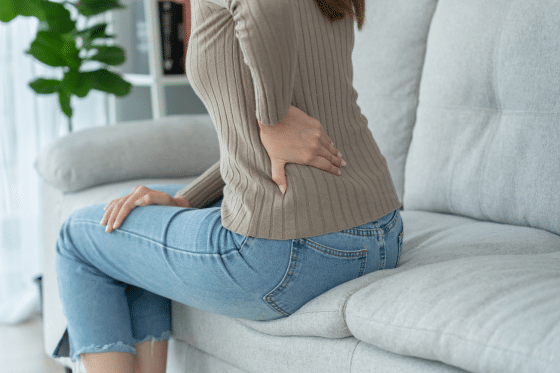
Back pain is one of the most common complaints, affecting millions of people worldwide. While many assume that their discomfort is caused by issues in their spine or muscles, the pelvis plays a crucial role in supporting the back and maintaining overall posture. An imbalance or dysfunction in the pelvis can lead to persistent back pain, mobility limitations, and discomfort that affects your daily activities.
Understanding the connection between the pelvis and back pain can help you address the root cause rather than just managing the symptoms. In this article, we’ll explore how pelvic alignment influences back pain, common conditions associated with pelvic dysfunction, and how you can correct imbalances to find lasting relief.
The Role of the Pelvis in Spinal Health
The pelvis is the foundation of your spine. It provides stability and balance, allowing your spine to maintain its natural curves and support your body weight. When the pelvis is properly aligned, your lower back (lumbar spine), hips, and core muscles work in harmony to keep you upright, move efficiently, and absorb impact from daily movements.
However, pelvic misalignment or weakness can create an uneven distribution of weight and stress on the spine, leading to pain and dysfunction. Since your pelvis connects to your lower spine, any shifts or imbalances in its positioning can directly affect your back.
Common signs that your pelvis may be contributing to back pain include:
- Pain that worsens with certain movements, like bending or twisting
- Persistent lower back pain that doesn’t go away with rest
- Tight hip flexors or hamstrings
- Uneven posture (one hip higher than the other)
- Difficulty standing or walking for long periods
How Pelvic Imbalances Lead to Back Pain
There are several ways the pelvis can contribute to back pain. Let’s break down the most common pelvic-related causes of back pain:
1. Anterior Pelvic Tilt (Excessive Forward Tilt)
An anterior pelvic tilt occurs when the front of the pelvis drops forward, increasing the arch in the lower back. This position tightens the hip flexors and weakens the abdominal and glute muscles. The excessive lumbar curve puts pressure on the lower spine, leading to chronic lower back pain and stiffness.
Signs of Anterior Pelvic Tilt:
- Lower back pain, especially after prolonged sitting or standing
- Tight hip flexors and weak glutes
- Overarching lower back when standing
Correction Strategies:
- Strengthen core and glute muscles
- Stretch hip flexors and lower back
- Improve posture awareness
2. Posterior Pelvic Tilt (Excessive Backward Tilt)
A posterior pelvic tilt is the opposite of an anterior tilt. In this case, the pelvis tilts backward, flattening the lower back curve. This can lead to tight hamstrings and weak hip flexors, creating strain on the lower spine and limiting mobility.
Signs of Posterior Pelvic Tilt:
- Flattened lower back
- Tight hamstrings
- Difficulty standing up straight
- Pain when bending forward
Correction Strategies:
- Stretch hamstrings and lower back
- Strengthen hip flexors and core
- Work on improving spinal mobility
3. Pelvic Instability and Weak Core Muscles
The pelvis needs strong core muscles to remain stable. Weak abdominal and glute muscles can cause excessive movement and imbalance, forcing the lower back to compensate. Over time, this leads to pain, tightness, and even an increased risk of injury.
Signs of Pelvic Instability:
- Weakness or wobbliness in the hips
- Back pain during movement
- Poor balance or frequent lower back strain
Correction Strategies:
- Strengthen deep core muscles
- Focus on pelvic floor activation
- Improve hip stability with targeted exercises
4. Leg Length Discrepancy and Pelvic Rotation
Some individuals have a natural or functional leg length discrepancy, where one leg is slightly longer than the other. This creates a tilted pelvis, forcing the spine to compensate. Over time, this imbalance can contribute to chronic back pain and hip discomfort.
Signs of Pelvic Rotation:
- One hip appears higher than the other
- Uneven gait when walking
- Back pain localized to one side
Correction Strategies:
- Chiropractic adjustments or physical therapy
- Custom orthotics if necessary
- Strength and mobility exercises for pelvic balance
How to Improve Pelvic Alignment and Reduce Back Pain
If your pelvis is a contributing factor to your back pain, the good news is that targeted exercises and lifestyle adjustments can make a significant difference. Here are some ways to improve pelvic alignment and reduce back pain:
1. Strengthen Your Core and Glutes
A strong core supports pelvic stability and reduces strain on the lower back. Focus on:
- Planks (front and side planks)
- Glute bridges
- Dead bugs and bird dogs
2. Stretch Tight Muscles
If you have an anterior pelvic tilt, stretch:
- Hip flexors (lunge stretch)
- Lower back (child’s pose)
- Quadriceps (standing quad stretch)
If you have a posterior pelvic tilt, stretch:
- Hamstrings (seated forward fold)
- Lower back (cat-cow stretch)
3. Improve Posture and Movement Habits
- Avoid prolonged sitting—stand up and move every 30-60 minutes
- Be mindful of your standing posture
- Use supportive footwear if leg length discrepancy is an issue
4. Consider Professional Guidance
If you’re struggling with persistent back pain, a physical therapist can assess your pelvic alignment, muscle imbalances, and movement patterns to develop a customized plan for relief. A free discovery visit is a great place to start!
Take the First Step Toward a Pain-Free Back!
If your back pain has been holding you back, it’s time to take action. Addressing pelvic alignment and muscle imbalances can make a huge difference in how your body moves and feels.
At Balance Within Integrative Physical Therapy, we provide personalized, integrative treatment plans to help with your back pain. Schedule a free discovery visit or a 15-minute phone consultation with Balance Within Integrative Physical Therapy today. Let’s create a customized plan to help you move pain-free. Book your consultation now!
